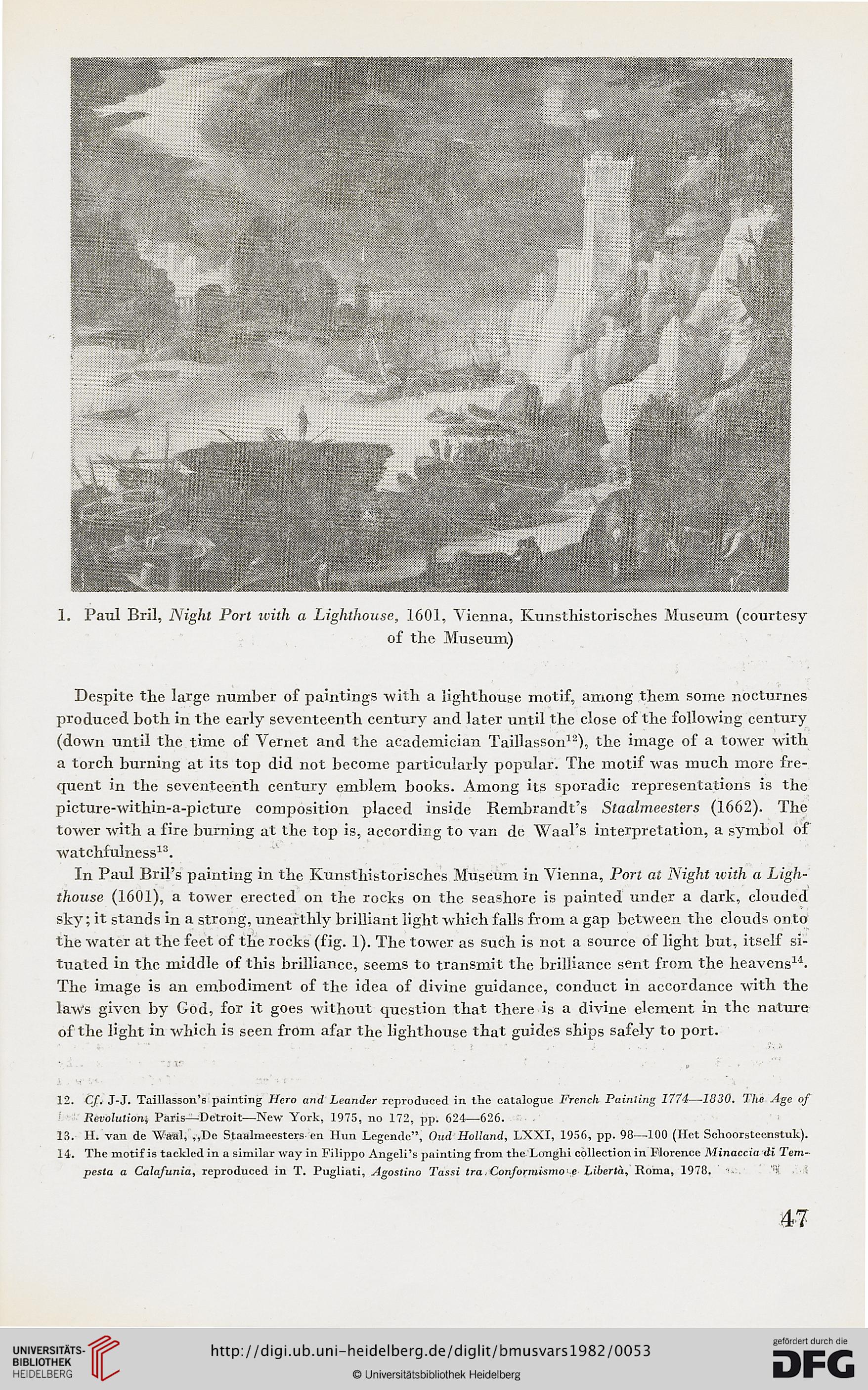1. Paul Bril, Night Port ivilh a Lighthouse, 1601, Vienna, Kunsthistorisches Muscum (courtcsy
of the Museum)
Despite the large number of paintings with a lighthouse motif, among them some nocturnes
produced both in the early seventeenth century and later until the close of the following ccntury
(down until the time of Vernet and the academician Taillasson12), the image of a tower with
a torch burning at its top did not become particularly popular. The motif was much more fre-
quent in the seventeenth century emblem books. Among its sporadic representations is the
picture-within-a-picture composition placed inside Rembrandt's Staalmeesters (1662). The
tower with a fire burning at the top is, according to van de Waal's interpretation, a symbol of
watchfulness13.
In Paul Bril's painting in the Kunsthistorisches Museum in Yienna, Port at Night with a Ligh-
thouse (1601), a tower erected on the rocks on the seashore is painted under a dark, clouded
sky; it stands in a strong, unearthly brilliant light which falls from a gap between the clouds onto
the water at the feet of the rocks (fig. 1). The tower as such is not a source of light but, itself si-
tuated in the middle of this brilliance, seems to transmit the brilliance sent from the heavens14.
The image is an embodiment of the idea of divine guidance, conduct in accordance with the
laws given by God, for it goes without question that there is a diyine element in the naturę
of the light in which is seen from afar the lighthouse that guides ships safely to port.
12. Cf. J-J. Taillasson's painting Hero and Leander reproduced in the cataloguc French Painting 1774—1830. The Age of
' : Revolulion\ Paris—Detroit—New York, 1975, no 172, pp. 624—626.
13. H. yan de WałU, „De Staalmeesters en Hun Legendę", Oud Holland, LXXI, 1956, pp. 98—100 (Het Schoorstecnstuk).
14. The motif is tackled in a similar way in 1'ilippo Angeli's painting from the Longhi collectionin Florence Minaccia di Tcm-
pesta a Calafunia, reproduced in T. Pugliati, Agostino Tassi tra. Conformismo ę Liberta, Roma, 1978. " . !K ;
47
of the Museum)
Despite the large number of paintings with a lighthouse motif, among them some nocturnes
produced both in the early seventeenth century and later until the close of the following ccntury
(down until the time of Vernet and the academician Taillasson12), the image of a tower with
a torch burning at its top did not become particularly popular. The motif was much more fre-
quent in the seventeenth century emblem books. Among its sporadic representations is the
picture-within-a-picture composition placed inside Rembrandt's Staalmeesters (1662). The
tower with a fire burning at the top is, according to van de Waal's interpretation, a symbol of
watchfulness13.
In Paul Bril's painting in the Kunsthistorisches Museum in Yienna, Port at Night with a Ligh-
thouse (1601), a tower erected on the rocks on the seashore is painted under a dark, clouded
sky; it stands in a strong, unearthly brilliant light which falls from a gap between the clouds onto
the water at the feet of the rocks (fig. 1). The tower as such is not a source of light but, itself si-
tuated in the middle of this brilliance, seems to transmit the brilliance sent from the heavens14.
The image is an embodiment of the idea of divine guidance, conduct in accordance with the
laws given by God, for it goes without question that there is a diyine element in the naturę
of the light in which is seen from afar the lighthouse that guides ships safely to port.
12. Cf. J-J. Taillasson's painting Hero and Leander reproduced in the cataloguc French Painting 1774—1830. The Age of
' : Revolulion\ Paris—Detroit—New York, 1975, no 172, pp. 624—626.
13. H. yan de WałU, „De Staalmeesters en Hun Legendę", Oud Holland, LXXI, 1956, pp. 98—100 (Het Schoorstecnstuk).
14. The motif is tackled in a similar way in 1'ilippo Angeli's painting from the Longhi collectionin Florence Minaccia di Tcm-
pesta a Calafunia, reproduced in T. Pugliati, Agostino Tassi tra. Conformismo ę Liberta, Roma, 1978. " . !K ;
47




